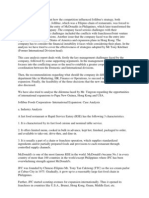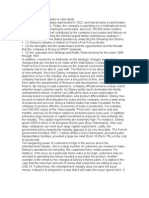Comprehensive Exam "Disney Production": Graduate School of Business MBA Program
Comprehensive Exam "Disney Production": Graduate School of Business MBA Program
Uploaded by
menoushCopyright:
Available Formats
Comprehensive Exam "Disney Production": Graduate School of Business MBA Program
Comprehensive Exam "Disney Production": Graduate School of Business MBA Program
Uploaded by
menoushOriginal Title
Copyright
Available Formats
Share this document
Did you find this document useful?
Is this content inappropriate?
Copyright:
Available Formats
Comprehensive Exam "Disney Production": Graduate School of Business MBA Program
Comprehensive Exam "Disney Production": Graduate School of Business MBA Program
Uploaded by
menoushCopyright:
Available Formats
Graduate School of Business MBA Program
De
Comprehensive Exam Disney Production
Name: Program: Major: Exam Date:
Mohamed Ali MOUSSA MBA Marketing. 16 April, 2004
In the direction of solving this case and providing my recommendations I follow the following outline: I. Introduction: In which a general historical overview will be done regarding Walt Productions as well as brief of problem identification. Step 1: Environmental Scanning This step will cover monitoring, evaluating, and disseminating of info from internal & external environments to key people within WDP (Walt Productions) Step 2: Strategy Formulation This step covers the developing of long-range plans for effective management of environmental Opportunities and Threats, in light of corporate Strengths and Weaknesses. From these developed alternatives, the best one should be selected. Step 3: Strategy Implementation Putting strategies and policies, that are generated and developed in the previous step, into actions Step4: Evaluation and Control This step covers the monitoring of WDP activities and evaluating them with respect to the desired performance and results. Step5: Feedback and learning Process Conclusion and recommendations. After showing the analysis, from WP point of view, Ill provide my recommendation as reflected from my own opinion. In this part Ill give more descriptive problem definition, then criticize the situation and put my recommendations
II.
III.
IV.
V.
VI. VII.
I.
Introduction
Walt Disney, the poor young boy but the very innovative, has created the idea to enter the gate of the business world. He decided to do a series about a mouse. Although it was very difficult to work at the early beginning, however it became one of the biggest companies in the entertainment world. Walt Disney, his brother Roy and another guy, Ub Iwerks, were the founders of this great giant. Starting with the very low techniques and financial resources to develop their early cartoon movies early 1900s and ending with WDW (Walt Disney World) at cost of $600 million, WP was growing too dramatically. Their market and financial positions were strong enough to be as a power of a country. Their reached their peak during the period between 1965 and 1970. However by losing their main competitive advantage; creativity, they started to decline. The main problem they faced is sliding of their earnings. The point was in the change of Management Philosophy. Yesterday, top management was focusing on good management as a tool to apply innovative ideas in order to attract people. Today, top management is squelching creativity; the main key competitive advantage and market leadership motivator.
II.
Step 1: Environmental Scanning
In this step all the major affecting factors, External and internal, will be assessed A. External Factors. The external factors are important in order to assess the degree of environmental uncertainty. External factors are usually categorized as, factors of Social Environment variables and factors of Task environment variables. i. Social environment (PEST) Political-Legal Forces: a. The world war affecting the money supply to the WDP since it was impounded abroad. Economic Forces: a. After the great recession, in the 1930s, it became more promising due to the better economic situation. b. Bad weather in harsh winters affects the purchase power, especially in Disney lands, since people will not prefer to go to open parks in winters. Socio-cultural Forces: a. A demographic change; the percentage of target segment age (under 14) has reduced from 18.2% in 1960s to 13.6% in 1980s. b. Market has been changed; the target segment became tending more towards more sophisticated points and contain more sexy and violent materials Technological Forces: a. The advancement in the technology improving the production and management processes. b. Patent protection increased and technology helped to put a barriers for intellectual and trade stealing. ii. Task environment: Using Porters competitive industry analysis a. Threats of new entrance: it is very high since the huge amount of financial and capital
resources that a new business unit could need to compete, directly or indirectly, with WDP. b. Rivalry among existing Firm: although the industry is consolidated, rivalry is high due to the high diversification in sorts of entertainments. Some of them are suiting much more the market changes. As an example Metro Golden Mayer. c. Threats of substitute products and services: changing of WDP is very difficult right now, although I do believe it is a must. d. Bargaining power of Buyers: it is very low as well. e. Bargaining Power of Supplier: it is low since WDP not depends on very sophisticated suppliers and do a lot of work in house. f. Relative power of other Stakeholder: it seemed to be high. Type of Industry: WDP is represented as Consolidated industry. As it might be noticed, the entertainment industry is dominated by large firms. No place for small business units, due to the high cost and entrance barrier. Strategic type: Actually WDP followed 2 different types of strategies in two different eras. Before 1970 era, WDP was Prospector since it was focus on product innovations and broad products. After 1970 era, WDP was Defender or reactor since it was trying only to improve the efficiency of their products or suffering from lack of consistency between strategy, culture, and market changes. iii. Analyzing external factors (EFAS) The EFAS Summary Table is shown in the next page:
B.
Internal Factors. Identifying core competencies: WDP has some core competencies: o Innovation o Good experience of the type of work. o High businesslike and competent stuff. Resource-based approach to organization analysis (VRIO) o Value: WDP used to have a competitive advantage value of Innovations. However, recently, WDP started to lose it. WDP also has good capital assets. o Rareness: innovation and good capital assets are rare. o Imitability: innovation is difficult to imitate and good capital assets is not easily found. o Organization: it used to be very reflective to these resources. Recently, it is not. Value chain analysis: As it was mentioned in the article, WDP moved vertically along the value chain. They had built their own distributors. They also built their fabrication. Organizational structures: o WDP started with the very simple structure, few people own the business and do every thing them selves. After a while it followed functional structure, in which there were many functional entities. At the final stage, WDP, opened new divisions (e.g. TV, Disney lands, WDW) and evolved and grew to Divisional Structure. Corporate culture. The major characteristics of WDP corporate culture: Manicured lawns and ethereal is conveying a campuslike atmosphere in WDP. Men had to have their hair cut above their ears and collars with clean shaven.
Women have to be natural without emphasized or noticeable make-up or wears. No eat, drink, smoke, curse, or chewing gum while working with public. Employee should keep the quite and nice smile and pleasure. WDP used to train their employees in a very good manner before they become in touch with the customers. Marketing Situation: o Segment: the main segment for WDP was the younger people (under 14). The sub segments include the parents as well. o Product life cycle: WDPs products (TV, Parks) are at the end of the growth phase and will start to decline if WDP will not change their strategy. In my opinion the WDW is in its growth phase. o Market mix: for products, WDP is focus on the good quality and good brand name. For Place it was very concentrated, specially regarding the parks, if they succeeded with the mini-Disney it will be good. For promotion it needs an aggressive advertising and promotion campaigns. financial situation : according to the financial ratios that are shown in the following page, here is some notices: o ROI is declined more than 1 third. o Operating Profit Margin show some increase. o ROE show increase which another good sign. o EPS and Current ratios declined by almost 30% which is bad signs.
Analyzing internal factors (IFAS) The EFAS Summary Table is shown:
III.
Step 2: Strategy Formulation
A. Mission. Unfortunately there is no stated mission statement in the given article. B. Objectives & Goals i. General Corporate Objectives Primary Objectives: is to provide the a good entertainment service for the primary target (younger) as well as the secondary one (Parents) Secondary Objectives: to have the good sink for million of dollars. Objectives vs. time horizon: the objectives were very long term objectives. However, WDP did not go with a very important step; which is verifying these long term objectives with the market changes.
i. Marketing Objectives Apply Ansoffs matrix of products vs Market, we will find that WDP used Diversifications C. Situational analysis: i. SFAS from the previous IFAS and EFAS tables, we can create the SFAS table as shown in the next page: D. i. Strategies Corporate Strategy
Directional Strategy o Growth strategies WDP worked in the growth strategy in its both directions;
Concentration by vertical integration going both forward and backward in the value chain by having its own distributors as well as some manufacturing. Diversification concentric or related entertainments sorts. Portfolio Strategy: it is working in the entertainment industry. Parenting Strategy: WDP is the owning parents for all other sub-units; movie industry, Parks, WDW, and the remains. ii. Business Strategy.
Competitive Strategies (Porter) o WDP used the Differentiation Strategies by its unique innovative ideas. It also worked to focus on certain demographic segment (younger) o Competitive tactics: At the first era, WDP was following Offensive starting from Guerrilla Warfare and ending with Frontal Assault. By time it changed to Defensive tactics. Cooperative Strategies: as it is not so clear in the given article, WDP did not have any alliances or collusion. iii. Functional Strategy.
Identifying core competencies: as shown before, the core competency for WDP was innovation. Sourcing decision; WDP tended to not outsource its activities, on contrary they made vertical integration. Marketing strategies: briefing of used marketing strategies is as follows: o Value Positioning / value disciplines: they used more for more strategy (more value for more money) o Push/ pull strategy: they followed Push strategy relying on promotions rather than advertisements (Pull). o They used Skim pricing strategy to skim the kream.
o They used value-pricing rather than costoriented or market-oriented techniques. E. Policies: the broad guideline was The Wonderful World of Disney. The key word is Wonderful and World to point to the amusing entertainment services as well as its very wide diversifications. IV.
Step 3: Strategy Implementation.
A. Who implement strategy: Started by the 3 persons, Walt, his Brother and Iwerks. And ended by Raymon Watsom, chairman, and Roland Miller as a presedent. What must be done B. How are strategies to be implemented? Organizing for actions Action plan: there were many action plans: a. In providing the 1st movies: b. In building Disneyland: Make designs. Lending money to continue planning. Alternative places. Choosing the proper place. Financing the operations. a. In building WDW Building Yesterday City Building Tomorrow City Designs Lands purchasing Financing. V. A.
Step 4: Evaluation and Control
Performance evaluation iv. Primary Measures of Corporate Performance:
Traditional financial measures: e.g. ROI reduced by more than 30% as shown previously in the financial ratios. Balanced Scorecard Learning and growth of the employees seemed to be OK. Internal process: is not totally OK, since it do not permit the innovative ideas to show-up.
Customer: WDP focused on customer satisfaction through high quality only. It did not run with the new market needs. Financial: is not so good and declining. Primary Measures of Divisional and Functional Performance. Use benchmarking with the previous history of WDP we found that the performance is declining. v.
VI.
Step 5: Feedback and learning process
In this step we should outline the major learned lessons: In my opinion, WDP should learn the following, as a higher level points: Not allow other competitors, even indirect ones, to be profit from its activities as happened with Disneyland. Key competitive advantages (innovation) should be always aliened with the objectives of the company. Use of all the resources efficiently.
VII.
Conclusion and Recommendations.
i. Problem Definition WDP is facing a declining earning and losing there old position in the market. ii. Conclusion: WDP passed by 2 eras; before 1970, in which it was booming so fast and after 1970 where it started to face earnings decline. Company diversified their business. During the 1st era, innovation was the key Competitive advantage During 2nd era, the company started not to rely strongly on its main competitive advantage (innovation). Financial situation started to decline. It is needed to recommend solutions. Criticism: Objectives were SMART, Proactive, but unfortunately did not consider competitive advantage
iii.
iv.
Conflict between the new strategy and the corporate culture. Recommendations: In my opinion WDP need to work in 2 directions: Short run Direction: in which WDP might: a. Review its policies and processes to open the door for internal and external innovative ideas as a lot of companies did. b. Change the top management in order to get fresh blood. c. Retrench some of the activities as TV business unit and just focus on movie production. d. Retrench also the distributors and work with high and well known distributors. e. Go for very strong and comprehensive advertisements and other marketing tools. f. Re-conduct the mission and objectives very clearly to all the stakeholders. Long run Direction: a. Follow growth strategy by diversification through alliances which might improve their situation and might be better than vertical growth. b. Work with the mini-Disney. c. Fulfill the change in marketing needs by providing new products that mach these needs d. Put many segments, instead of only 2, and fulfill deferent products for each segment.
You might also like
- Life On Mars Poems by Tracy K Smith 1555975844 PDFDocument5 pagesLife On Mars Poems by Tracy K Smith 1555975844 PDFMonica Montero0% (1)
- JollibeeDocument12 pagesJollibeePankaj Sahu67% (3)
- ANALYSIS of Walt Disney CaseDocument11 pagesANALYSIS of Walt Disney CaseStacy D'Souza100% (3)
- Walt Disney Company Case Study and Strategic PlanDocument27 pagesWalt Disney Company Case Study and Strategic PlanKamran Irshad KhanNo ratings yet
- Chap 011Document21 pagesChap 011kianhuei50% (2)
- Phanikumar TransportPhenomenaNotes 01feb2010Document109 pagesPhanikumar TransportPhenomenaNotes 01feb2010aalisafa50% (2)
- Jane Dueber - Module 1 Action GuideDocument14 pagesJane Dueber - Module 1 Action GuideVincent J100% (1)
- SQL Questions & AnswersDocument9 pagesSQL Questions & AnswersTsehayou SieleyNo ratings yet
- An Analysis of The Strategic ChallengesDocument34 pagesAn Analysis of The Strategic ChallengesBenny HendartoNo ratings yet
- Waltdisney2 PPT CrdownloadDocument33 pagesWaltdisney2 PPT CrdownloadRaman ManchandaNo ratings yet
- Slide - Open Case Discussion (Sample) - Disney Adds Value Using A Related Diversification StrategyDocument22 pagesSlide - Open Case Discussion (Sample) - Disney Adds Value Using A Related Diversification StrategySumon iqbalNo ratings yet
- CM STRAT-Saloner-Shepard-Podolny PDFDocument13 pagesCM STRAT-Saloner-Shepard-Podolny PDFmeherey2k100% (1)
- Ravshan Suyunov Final EnterpreneurshipDocument5 pagesRavshan Suyunov Final EnterpreneurshipzazaNo ratings yet
- The Walt Disney Company VisionDocument3 pagesThe Walt Disney Company Visionimran khanNo ratings yet
- Maketing Plan PDFDocument3 pagesMaketing Plan PDFimran khanNo ratings yet
- 2-Instructions For MARKETING PLAN 2ndDocument5 pages2-Instructions For MARKETING PLAN 2ndGerard MNLNo ratings yet
- Seminar 2 - KoreaDocument52 pagesSeminar 2 - KoreaystxzsNo ratings yet
- W2:The Marketing Enviroment: The Microenvironment: Consists of The Actors CloseDocument10 pagesW2:The Marketing Enviroment: The Microenvironment: Consists of The Actors CloseMai Hương QuỳnhNo ratings yet
- The Strategy of IBDocument3 pagesThe Strategy of IBRahul BanerjeeNo ratings yet
- 03686720190905165755Document29 pages03686720190905165755Pratik Jaiswal100% (2)
- Strategic ManagementDocument9 pagesStrategic ManagementShreyas ZeleNo ratings yet
- Strategies in Action Session 5 Professor Hilda L. Teodoro Ateneo Graduate School of BusinessDocument42 pagesStrategies in Action Session 5 Professor Hilda L. Teodoro Ateneo Graduate School of BusinessMonica PangemananNo ratings yet
- Business Case StudyDocument8 pagesBusiness Case StudyAgustin LopezNo ratings yet
- Future Retail AssignmentDocument11 pagesFuture Retail AssignmentAditya TripathiNo ratings yet
- Unit 4 - Activity SheetsDocument2 pagesUnit 4 - Activity SheetsJudy Mar Valdez, CPANo ratings yet
- International Business: Bpo - Bane or Boon ?Document8 pagesInternational Business: Bpo - Bane or Boon ?Sushma Raju GowdaNo ratings yet
- Strategic Audit of Samsung Corporation: Analysis of Strategic Factors - Based On The SWOT Analysis and TheDocument16 pagesStrategic Audit of Samsung Corporation: Analysis of Strategic Factors - Based On The SWOT Analysis and TheAmi ImranNo ratings yet
- Quiz Emerging Economies Prepared by Naval BhushaniaDocument3 pagesQuiz Emerging Economies Prepared by Naval BhushaniaNaval BhushaniaNo ratings yet
- Case 1 Blockbuster ImageDocument4 pagesCase 1 Blockbuster ImageTony PhanNo ratings yet
- Introduction To Marketing and The Global MarketplaceDocument37 pagesIntroduction To Marketing and The Global MarketplaceHeleen KistNo ratings yet
- Ibiii MMC PDFDocument315 pagesIbiii MMC PDFPraveen Kumar PiarNo ratings yet
- Strategy Presentation Group 8Document62 pagesStrategy Presentation Group 8Shivani BhatiaNo ratings yet
- Disney Diversification and Swot AnalysisDocument9 pagesDisney Diversification and Swot Analysisapi-251907197No ratings yet
- Transcription - Org ViabilityDocument5 pagesTranscription - Org Viabilitymanoj reddyNo ratings yet
- Business StrategyDocument8 pagesBusiness Strategyabdulrazzaqmemon36No ratings yet
- Univesity of The East Caloocan CaloocanDocument5 pagesUnivesity of The East Caloocan CaloocanJean CabigaoNo ratings yet
- Amore PacificDocument12 pagesAmore PacificAditiaSoviaNo ratings yet
- The Walt Disney CompanyDocument6 pagesThe Walt Disney Companybpowell2No ratings yet
- DoveDocument14 pagesDoveAndrei GRIGORICANo ratings yet
- Global Entre Review 1-6Document8 pagesGlobal Entre Review 1-6Viola Ari PutriNo ratings yet
- Bop 111Document15 pagesBop 111aafaque shaikhNo ratings yet
- Executive-Summary (Nishi)Document10 pagesExecutive-Summary (Nishi)Sanzida Sharmin RifaNo ratings yet
- 12 - Global Brands & Local MarketsDocument16 pages12 - Global Brands & Local MarketsShaliesh SoniNo ratings yet
- TWOS MatrixDocument5 pagesTWOS Matrixnash kentNo ratings yet
- 1.1.6 Business PlansDocument8 pages1.1.6 Business PlansWanna One HatsuneNo ratings yet
- The Strategy of International Business: Chapter OutlineDocument21 pagesThe Strategy of International Business: Chapter OutlineManzar HussainNo ratings yet
- Module 1 Introduction:: Marketing VirtualDocument9 pagesModule 1 Introduction:: Marketing VirtualViviana VargasNo ratings yet
- Bes 3RD Qe ?Document9 pagesBes 3RD Qe ?9kr5vk9r98No ratings yet
- Strategic Audit of The Walt Disney CompanyDocument18 pagesStrategic Audit of The Walt Disney CompanyAna Irina Lechintan100% (3)
- 12 - Global Brands & Local MarketsDocument16 pages12 - Global Brands & Local MarketsManish ParasharNo ratings yet
- ASAL Business Coursebook Answers PDF 5Document10 pagesASAL Business Coursebook Answers PDF 5HanNo ratings yet
- Strategy and The Enterprise in International ContextsDocument16 pagesStrategy and The Enterprise in International Contextsangela krleskaNo ratings yet
- Business Plan Final ProjectDocument10 pagesBusiness Plan Final ProjectMartina AttallahNo ratings yet
- "Fundamental Analysis of Voltas": P.E.S Institute of Technology Department of MBADocument17 pages"Fundamental Analysis of Voltas": P.E.S Institute of Technology Department of MBAJennifer SmithNo ratings yet
- Riassunto 1 Midterm Principles of ManagementDocument25 pagesRiassunto 1 Midterm Principles of ManagementEnrico IonioNo ratings yet
- BF Module 11Document29 pagesBF Module 11Bianca SyNo ratings yet
- MKT 6203Document8 pagesMKT 6203Kashfia AminNo ratings yet
- Commerce Jayesh AgarwalDocument17 pagesCommerce Jayesh Agarwaljayshree agarwal100% (3)
- International Business: Marketing StrategyDocument18 pagesInternational Business: Marketing StrategyMinh MèoNo ratings yet
- Red Ocean TrapsDocument12 pagesRed Ocean TrapsNeeraj GargNo ratings yet
- UCU 104 Lesson 3Document10 pagesUCU 104 Lesson 3Matt HeavenNo ratings yet
- The Well-Timed Strategy (Review and Analysis of Navarro's Book)From EverandThe Well-Timed Strategy (Review and Analysis of Navarro's Book)No ratings yet
- Model Answer: E-Commerce store launch by Unilever in Sri LankaFrom EverandModel Answer: E-Commerce store launch by Unilever in Sri LankaNo ratings yet
- Sample Form FormsDocument4 pagesSample Form FormsRhex TVNo ratings yet
- Apc smx3000lv User ManualDocument10 pagesApc smx3000lv User ManualColour BlindNo ratings yet
- Eiph2 Eiph3 Eiph5 Eiph6: Internal Gear PumpsDocument24 pagesEiph2 Eiph3 Eiph5 Eiph6: Internal Gear PumpsHahaha HahahaNo ratings yet
- Ontogeny of The Social Brain in Utero and in InfancyDocument7 pagesOntogeny of The Social Brain in Utero and in InfancyFatima LewinnekNo ratings yet
- Subestación HVLCCDocument44 pagesSubestación HVLCCAlejandroNo ratings yet
- Surface AdditivesDocument24 pagesSurface AdditivesHai PhongNo ratings yet
- 4.3:4.4 GizmoDocument5 pages4.3:4.4 GizmoJaedyn C100% (1)
- Marine ONYX® Systems: Approved Components For Marine ApplicationsDocument4 pagesMarine ONYX® Systems: Approved Components For Marine ApplicationsDANIEL HERNANDEZ HUASASQUICHENo ratings yet
- Move Play Through Traditional Games Lesson Plan Grade 4 Social May 29 18 UpdatedDocument8 pagesMove Play Through Traditional Games Lesson Plan Grade 4 Social May 29 18 UpdatedKyle Dhaniel VelascoNo ratings yet
- Chapter 4 OrganizingDocument39 pagesChapter 4 OrganizingHanzel Dy NietesNo ratings yet
- DLL For Contemporary Philippine Arts From The RegionDocument5 pagesDLL For Contemporary Philippine Arts From The RegionWareen CablaidaNo ratings yet
- Lecture 15 Ergonomics in Product Design PDFDocument19 pagesLecture 15 Ergonomics in Product Design PDFKarandeep SinghNo ratings yet
- Acvxcv CV XCVXCCV CVDocument1 pageAcvxcv CV XCVXCCV CVgarza_aNo ratings yet
- QuestionnaireDocument3 pagesQuestionnaireCoordinator MtechNo ratings yet
- Catalog: Control Valves For Heating, Ventilation and Air-Conditioning SystemsDocument278 pagesCatalog: Control Valves For Heating, Ventilation and Air-Conditioning SystemsandreyNo ratings yet
- Condition of The Surface of Commutators and Rings-Roughness: Technical Note Sta Be 16-1 GBDocument2 pagesCondition of The Surface of Commutators and Rings-Roughness: Technical Note Sta Be 16-1 GBloulou_beNo ratings yet
- Metro Lite SystemDocument14 pagesMetro Lite SystemAPEXA ARYANo ratings yet
- Fast Track Pro Drivers Read MeDocument3 pagesFast Track Pro Drivers Read MeMatt JerniganNo ratings yet
- 2024-JEE Advanced Full Test-1 - Paper-2 - Solutions PDFDocument16 pages2024-JEE Advanced Full Test-1 - Paper-2 - Solutions PDFSamNo ratings yet
- Econometrics Term Paper IdeasDocument7 pagesEconometrics Term Paper Ideasaflsbegdo100% (2)
- Document 6Document30 pagesDocument 6Krizamay Ongat AggerNo ratings yet
- TIHK Query Sheet No.139.6Document1 pageTIHK Query Sheet No.139.6asd2sas2No ratings yet
- Holiday Inn Express Paris - Velizy: Your Confirmation Number Is: 85701768Document3 pagesHoliday Inn Express Paris - Velizy: Your Confirmation Number Is: 85701768amal alruqi100% (1)
- Virtual AccountDocument9 pagesVirtual AccountAchal wankhadeNo ratings yet
- Microwave AntennaDocument100 pagesMicrowave AntennaJhill-Jhill Jimenez Dela PeñaNo ratings yet
- Sim Civil-Engineering-1930 1959-08 29 8Document149 pagesSim Civil-Engineering-1930 1959-08 29 8Riccardo CavalliniNo ratings yet

























































































